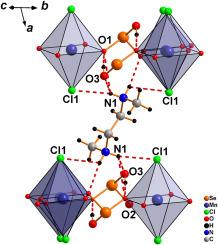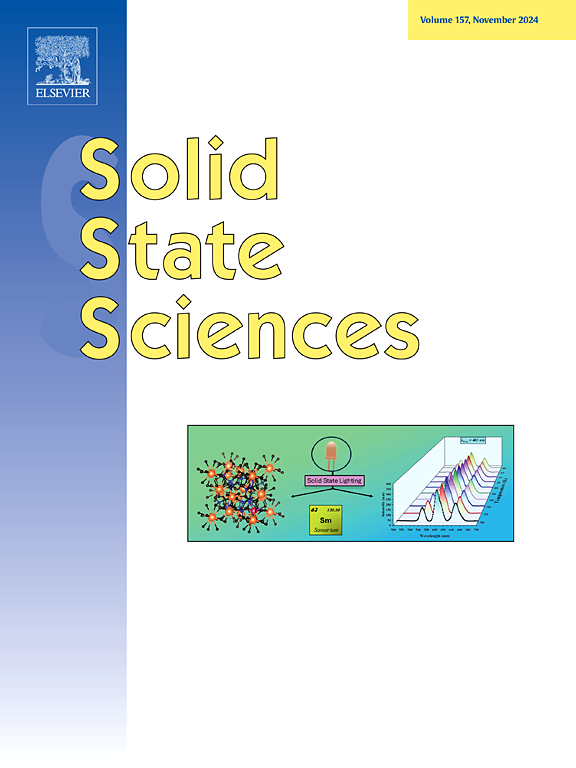N,N′-dimethylethylenediammonium cation as a template for layered inorganic frameworks and beyond
IF 3.3
3区 化学
Q2 CHEMISTRY, INORGANIC & NUCLEAR
引用次数: 0
Abstract
The templating role of the N,N′-dimethylethylenediammonium (dmedaH2)2+ cation in the synthesis of layered inorganic frameworks has been focused on transition metal hydroselenites and hydrophosphites. Under this work new compounds with the general formula (dmedaH2)[M(HSeO3)2X2] (M = Mn, Co, Cu, Cd; X = Cl, Br) and (dmedaH2)[Mn(H2PO3)2Cl2], which adopt layered structures with distinct hydrogen-bonded motifs, have been synthesized and characterized by single crystal X-ray analysis. The (dmedaH2)2+ cation exhibits a dual role: stabilizing targeted 2D architectures and directing the formation of side products, such as (dmedaH2)[Cd2Cl4(HSeO3)2]·2H2O and (dmedaH2)[Cu(SeO2Br)Br3] (containing rare SeO2Br− anions). Topological analysis reveals the structural complexity and connectivity of these stuctures, highlighting the interplay between cation geometry and inorganic layers. The work underscores the templating potential of dmedaH22+ in designing novel materials, while also demonstrating limitations imposed by steric and electronic factors. These findings advance the understanding of organic-inorganic hybrid systems and their structural diversity.

N,N ' -二甲基乙二铵阳离子作为层状无机框架及其他模板
N,N ' -二甲基乙二铵(dmedaH2)2+阳离子在层状无机骨架合成中的模板作用主要集中在过渡金属氢亚硒酸盐和氢亚磷酸盐上。本文合成了具有不同氢键基序的层状结构的新化合物(dmedaH2)[M(HSeO3)2X2] (M = Mn, Co, Cu, Cd; X = Cl, Br)和(dmedaH2)[Mn(H2PO3)2Cl2],并用单晶X射线分析对其进行了表征。(dmedaH2)2+阳离子表现出双重作用:稳定目标二维结构和指导副产物的形成,如(dmedaH2)[Cd2Cl4(HSeO3)2]·2H2O和(dmedaH2)[Cu(SeO2Br)Br3](含有稀有的SeO2Br−阴离子)。拓扑分析揭示了这些结构的结构复杂性和连通性,突出了阳离子几何和无机层之间的相互作用。这项工作强调了dmedaH22+在设计新材料方面的模板潜力,同时也证明了空间和电子因素所施加的限制。这些发现促进了对有机-无机杂化体系及其结构多样性的认识。
本文章由计算机程序翻译,如有差异,请以英文原文为准。
求助全文
约1分钟内获得全文
求助全文
来源期刊

Solid State Sciences
化学-无机化学与核化学
CiteScore
6.60
自引率
2.90%
发文量
214
审稿时长
27 days
期刊介绍:
Solid State Sciences is the journal for researchers from the broad solid state chemistry and physics community. It publishes key articles on all aspects of solid state synthesis, structure-property relationships, theory and functionalities, in relation with experiments.
Key topics for stand-alone papers and special issues:
-Novel ways of synthesis, inorganic functional materials, including porous and glassy materials, hybrid organic-inorganic compounds and nanomaterials
-Physical properties, emphasizing but not limited to the electrical, magnetical and optical features
-Materials related to information technology and energy and environmental sciences.
The journal publishes feature articles from experts in the field upon invitation.
Solid State Sciences - your gateway to energy-related materials.
 求助内容:
求助内容: 应助结果提醒方式:
应助结果提醒方式:


